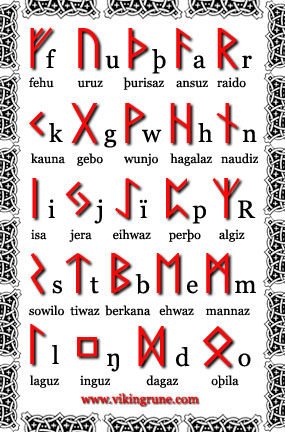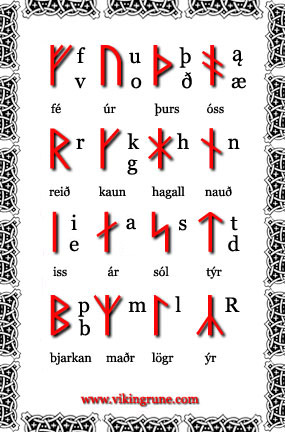Nordic runes are writing systems developed by Germanic tribes. It is not certain whether the first Germanic runic alphabet was based on a preceding form of writing, for instance Old Italic alphabets. It may well be an original Nordic invention, since the oldest runic inscriptions were discovered in Northern Germany and Denmark. The word Futhark is derived from the first six symbols in the rune row. Runes were used to carve inscriptions on various objects as well as on large stones known as runestones. The branch of linguistics that studies runes is called runology. Runic alphabets were used before the adoption of the Roman letters by the North Germanic peoples and, for some limited purposes, for a long time after.
Elder Futhark Runes: Proto-Norse Language
 The Elder Futhark runic alphabet was in use from the 2nd to 8th centuries. The language it transcribed was Proto-Norse. We neither have a developed literature in that language, nor even a complete grammar of it. Elder Futhark inscriptions are rather obscure, their meaning is often only tentatively reconstructed. Proto-Norse did not have any stable orthography, the same words being carved differently by different rune masters. On some ancient Germanic artifacts 24 runes are divided into three groups of eight. Each group is referred to as an Ætt, meaning ‘family.’ The names of individual Nordic runes are reconstructed, they are nowhere attested in the original Proto-Norse. However, the reconstruction is rather certain, being based on the later names of Gothic letters and Scandinavian ‘rune poems’ (medieval explanations given in verse to the Younger Futhark runes).
The Elder Futhark runic alphabet was in use from the 2nd to 8th centuries. The language it transcribed was Proto-Norse. We neither have a developed literature in that language, nor even a complete grammar of it. Elder Futhark inscriptions are rather obscure, their meaning is often only tentatively reconstructed. Proto-Norse did not have any stable orthography, the same words being carved differently by different rune masters. On some ancient Germanic artifacts 24 runes are divided into three groups of eight. Each group is referred to as an Ætt, meaning ‘family.’ The names of individual Nordic runes are reconstructed, they are nowhere attested in the original Proto-Norse. However, the reconstruction is rather certain, being based on the later names of Gothic letters and Scandinavian ‘rune poems’ (medieval explanations given in verse to the Younger Futhark runes).
Younger Futhark Runes: Old Norse Language
 The Younger Futhark runes were used in Scandinavia from the 9th through the 11th centuries. The reform of the alphabet effected by an unknown rune master was called forth by an important change in the language: Proto-Norse evolved into Old Norse. However, the language of the runic inscriptions is more archaic than the Old Norse of the Icelandic sagas written down in the 12th century. Younger Futhark is the runic alphabet that was in use during the Viking Age. Thus Vikings never carved their runestones with the Elder Futhark staves. Younger Futhark has only sixteen runes. The standard set of this Nordic runic alphabet is known as Danish runes or long branch runes. Runes used by Swedish and Norwegian Vikings were slightly different. They are known as short twig runes. Later version of the Younger Futhark is known as medieval runes.
The Younger Futhark runes were used in Scandinavia from the 9th through the 11th centuries. The reform of the alphabet effected by an unknown rune master was called forth by an important change in the language: Proto-Norse evolved into Old Norse. However, the language of the runic inscriptions is more archaic than the Old Norse of the Icelandic sagas written down in the 12th century. Younger Futhark is the runic alphabet that was in use during the Viking Age. Thus Vikings never carved their runestones with the Elder Futhark staves. Younger Futhark has only sixteen runes. The standard set of this Nordic runic alphabet is known as Danish runes or long branch runes. Runes used by Swedish and Norwegian Vikings were slightly different. They are known as short twig runes. Later version of the Younger Futhark is known as medieval runes.

I would like to rewrite chemical structures with the runes of old futhark, for a Design.
Since there is no C in this alphabet, this is quite difficult however.
I see there is a C in some newer version which basically looks like the apostroph ‘. For the high number of occurances this would look quite boring however, therefore I was wondering if there are any accounts of words like “anchor” “base” or “foundation” written in futhark.
Cheers,
Mike
Hi guys,
This is a great website!
However I do require some assistance to make sure I get it right.
I would like to get my sons name as a tattoo in younger futhark runes.
His name is: Caspian
Thanks
Alex
Basically, you will create a stave with runes by writing his name. Just be aware of a possible circumstances.
Alex, our rune converter would help you to write your son’s name in runes.
I a quite new to all of this and I still don’t really know a lot about this alphabet. But I wanted to know about it because I am working on something, and I was wondering if it is possible to translate the Greek (or Latin) alphabet into runes. I don’t know if it makes any sense but, I don’t need the characters to be directly translated. But more like the meaning of the characters.(for instance how “alpha” is associated with first and well being the alpha ).
I basically need this for “Alpha” , “Beta” and “Omega”
Bernhild, theoretically you may use the first and the last runes for alpha and omega. Not sure as for how beta would fit into this.
hello , I am hoping you can settle a dispute for me. I am arguing with someone about which direction the S is written I am arguing the way it is on this site is correct but he is insisting it goes the other direction.
Hello Ashlin. Younger or Elder Futhark?
In Elder Fuþark you can write it both ways. There was no set rule for direction of writing. Right to left or left to right, mirrored runes, they´re all possible.
What is danish rune for forge
Hello Andy. Runes do not usually represent whole notions. It’s basically an alphabet.
Hello,
My grandfather is from Denmark and is very sick with Alzheimer’s Disease. He is in the late stages and close to death. I want to get a tattoo in his memory. I want it to say “Remember Me” in Danish Runes but I am having difficulty with the translation. Can you help? I know in Danish it’s “Husk Mig”.
What runes would one use with the family originating on the Southern German/French border?
Hello Ken. Elder Futhark is the oldest runic alphabet that was used by all Germanic tribes, so you might want to opt for it. However, there is no law forbidding you to choose any other runic system.
Hi I am having trouble finding the translation of the word family into runes. I translated family into old norse or icelandic and came up with “Fjölskylda” and I see that there is no runes for the letters j and y so i am a bit confused. Please help me if you can, this is an idea i want for a tattoo and really need some help. Thank you!
Hello Kayla. The chart in the following article will help: Younger Futhark Runes and Later Developments.
Hi there. my name is Josh Syverson. let me first start off by saying what a wonderful website you have created here. with a lot of interesting and very cool resources for additional information. I have been so very curious about a coin that I metal detected. it was found in Duluth, MN near the shore. its a coin with a ship and sail on both sides. I was told it has elder futhark runes along the edges of both sides and that it says something along the lines of ” gift to the skraelings for being let use farmland along our journey” its very interesting and looks amazing. a few expert coin collectors scoured their resources to only come up empty on their search. the coin has never been cataloged anywhere. I was hoping you could give me any information that would help me figure out the history behind this artifact and its rarity etc. I would very much appreciate your time. if you cannot help me maybe you could point me in the right direction on who I could contact about something like this. the University of MN told me they didn’t deal with any artifacts not related to MN ( I don’t see how that is because I found it in MN) it was 6 inches underground and was shimmering in the sun light when I uncovered it. I could send you a few detailed photos if you are interested in taking a look at it. maybe you could translate the runes on it for me to see what you can come up with. thank you so much for reading this and I hope to hear back from you soon.
Have a great day!
Josh Syverson
Hello Josh. It is very unlikely that the coin is genuine. If you would like to send me the pictures, feel free to do so via my Facebook page.
I just want to make sure I’m not mistaken. The rune “oss” equates to a” and ‘ae’, and the rune “ar” equates to ‘e’ and ‘o’ right? Well I noticed that in the translator ‘a’ and ‘e’ are translated to the “ar” rune and o under the “oss” rune. This seems to be a mix up in translation. The “ar” rune translates to ‘a’ and ‘o’, while “oss” translates to ‘e’ and an ‘ae’. Am I wrong or did I find a typo?
Hello. If by ‘ae’ you mean ‘æ’ as a single phoneme, this is not supported in the converter, since it is for modern English, not for Old Norse words, as stated in the disclaimer. Letters ‘ae’ are treated as two separate letters, ‘a’ and ‘e’, and converted accordingly. Younger Futhark did not have a separate rune for each sound, so for many sounds that were considered to be similar one and the same rune was used. More on this in my article Younger Futhark Runes and Later Developments.